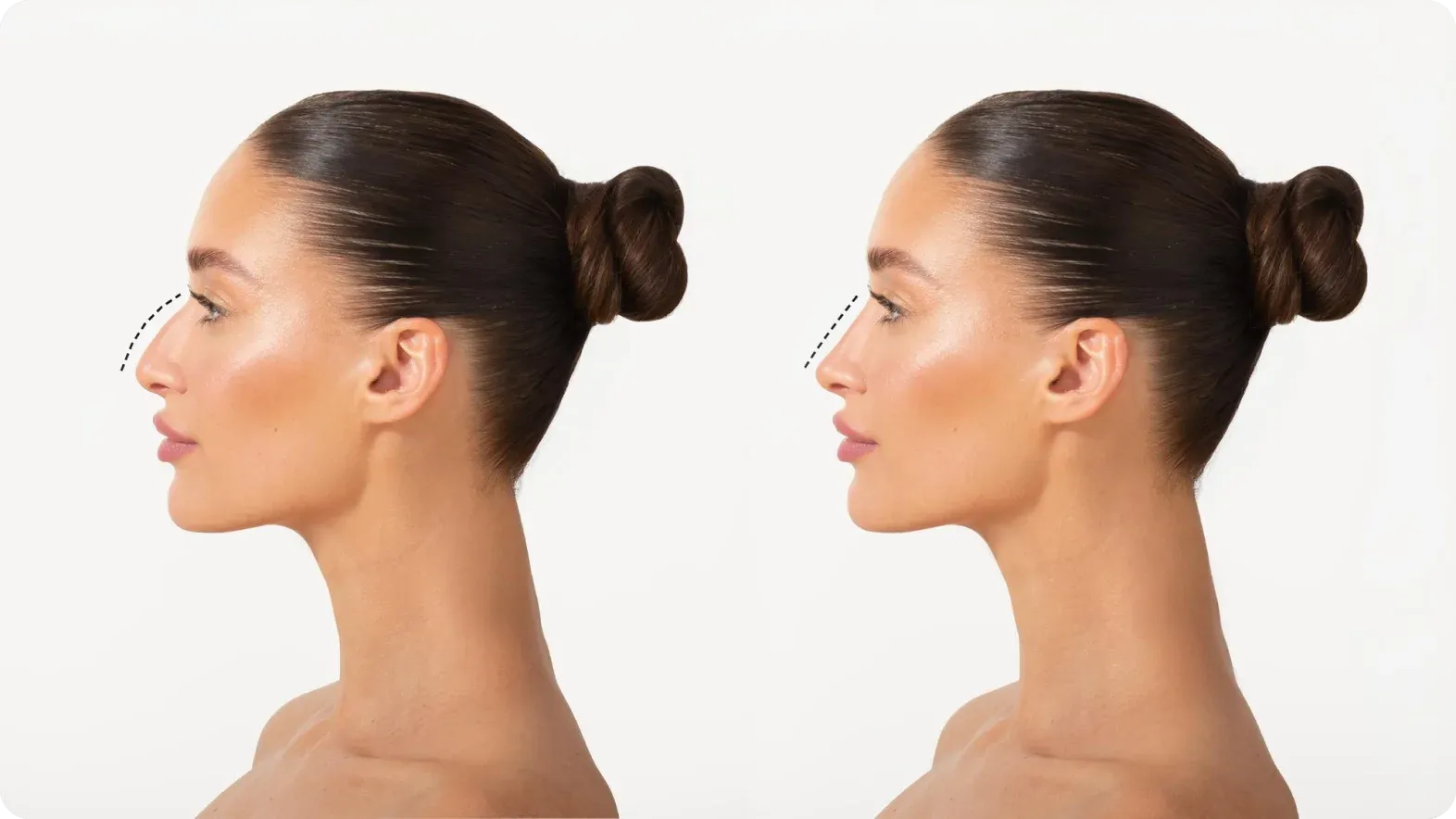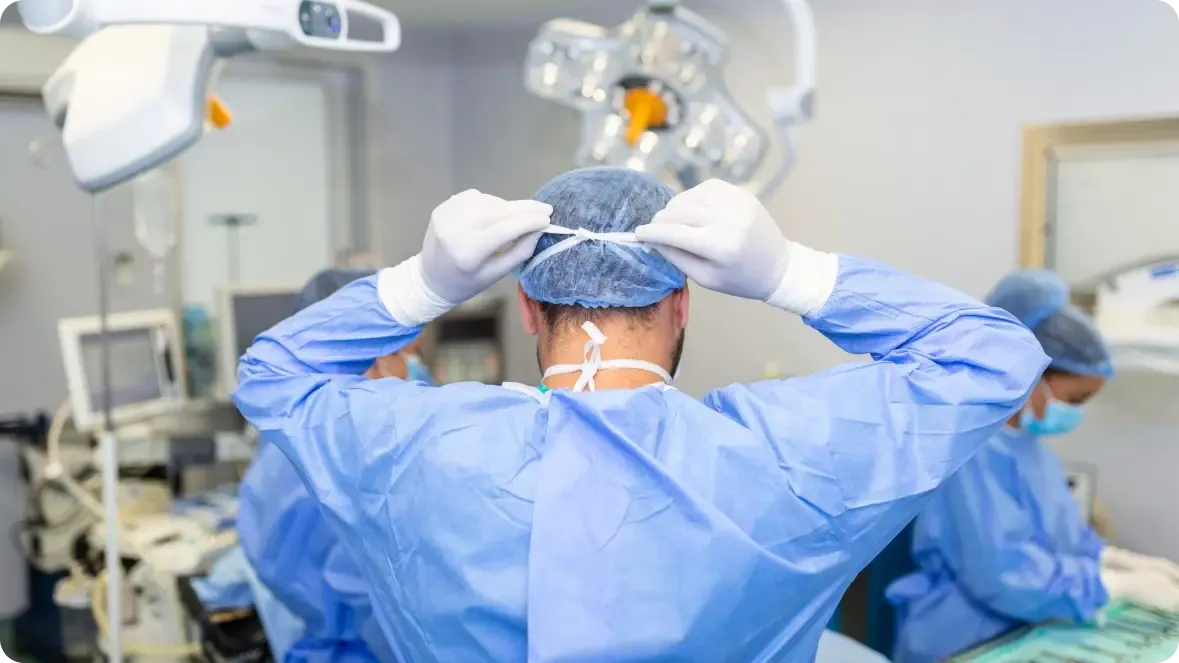Rhinoplasty Risks and Complications: What’s Realistic, What’s Rare — Transparency Builds Trust
November 18, 2025
Rhinoplasty is one of the most technically demanding surgeries in facial plastic surgery. You’re reshaping a complex, load-bearing structure (the nose) that has to both work and look good for decades. That’s why talking through risks isn’t just a legal box to check—it’s how trust is built and lasting results are made.
Below, we translate the evidence and specialist consensus into plain English: what you can expect after surgery, what occasionally goes wrong, and what’s truly rare. We’ll also cover how your anatomy, medical history, and your surgeon’s approach shape outcomes—and how you can do your part to keep risks low.
Below, we translate the evidence and specialist consensus into plain English: what you can expect after surgery, what occasionally goes wrong, and what’s truly rare. We’ll also cover how your anatomy, medical history, and your surgeon’s approach shape outcomes—and how you can do your part to keep risks low.
Setting Realistic Expectations: Baseline Risks Versus Rare Events
Studies don’t all define “complications” the same way. Some count every hiccup; others only tally issues that change the outcome or require intervention. The trend is toward using standardized, clear definitions—good news for transparency.
Evidence-based rates and definitions
Evidence-based rates and definitions
Functional and aesthetic endpoints
Time course and maturation
Patient-reported outcomes matter
- Common postoperative effects—bruising, swelling, congestion, crusting—are expected and usually short-lived. They’re not “complications.”
- True complications are unplanned problems that need treatment, slow recovery, or harm function or appearance (think infection, septal hematoma, valve collapse).
- Revision surgery is an outcome measure, not a complication. In peer-reviewed series, revision rates are generally 5–15%, reflecting case difficulty and individual expectations.
Functional and aesthetic endpoints
- Functionally, the goals are stable septal support, open internal and external nasal valves, and better airflow if breathing is an issue.
- Aesthetically, it’s about proportion, symmetry, and definition tailored to each face and skin type. Millimeters matter.
Time course and maturation
- Most swelling fades over the first 3 months; tip refinement can evolve for 12–18 months—especially in thicker skin.
- Unless there’s an urgent issue (infection, hematoma, major valve collapse), surgeons usually wait 9–12 months before planning a revision so tissues can fully settle.
Patient-reported outcomes matter
- Tools like NOSE (Nasal Obstruction Symptom Evaluation), SCHNOS (Standardized Cosmesis and Health Nasal Outcome Survey), and ROE (Rhinoplasty Outcome Evaluation) measure both breathing and satisfaction.
- What drives satisfaction? Aligned expectations, honest discussion of trade-offs, clear communication, and good aftercare—often more than any single technical move.

Patient-Specific Risk Factors and Candidacy
Your anatomy, health, and mindset all shape the plan—and the risk.
Anatomical variables
- Skin thickness: Thick, oily skin can soften tip definition and hold swelling longer; thin skin can show tiny irregularities. This influences graft choice and contouring.
- Tip support: Weak lower lateral cartilages can cause tip droop and external valve collapse—reinforcement may be needed.
- Septal integrity: A deviated, fractured, or previously harvested septum limits graft options and adds complexity.
- Valve dynamics: Pre-existing internal or external valve weakness must be identified and addressed (spreader grafts, lateral crural support) to avoid ongoing obstruction.
Medical and lifestyle factors
- Smoking/nicotine: Raises the risk of skin loss, infection, and slow healing. Most surgeons require stopping at least 4 weeks before and after surgery.
- Medications and supplements: Anticoagulants, NSAIDs, and supplements like ginkgo, ginseng, and high-dose fish oil can increase bleeding. A thorough review and holds are essential.
- Allergic rhinitis and sinusitis: Poorly controlled inflammation worsens swelling and congestion. Optimize treatment beforehand.
- Isotretinoin: Traditionally avoided for 6 months before/after surgery. Newer data suggest skin-healing risk is likely lower than once thought, but many surgeons still prefer a conservative interval. Coordinate timing with your surgeon and dermatologist.
Primary versus revision rhinoplasty
- Revisions involve scarred tissue, altered blood supply, and less septal cartilage. Rib or ear cartilage may be needed. Expect a higher chance of prolonged swelling and stiffness.
- Goals should reflect a narrower margin for change and more unpredictability.
Psychosocial screening and expectation alignment
- Careful conversations and visual planning (photo morphs or 3D imaging) help align what’s possible with what you want.
- Body dysmorphic symptoms are more common in cosmetic patients. Ethical care includes screening and, when appropriate, psychological support—or deferring surgery.
Operative Technique Choices That Influence Risk
There’s no one “right” technique—only thoughtful trade-offs.
Open versus closed approach
- Open (external) rhinoplasty uses a small incision on the columella for direct exposure—great for precise grafting and complex reconstructions. The tiny external scar usually fades well; visible scarring is uncommon.
- Closed (endonasal) rhinoplasty avoids an external incision and can cause less early swelling, but exposure is more limited. Long-term results hinge more on surgeon skill than approach.
Structural grafting options
- Septal cartilage: Often the first choice—good strength and shape. Limited in revisions or severe deviations.
- Auricular (ear) cartilage: Useful for contouring and alar support; naturally curved and less rigid.
- Costal (rib) cartilage: Offers volume for major support needs; carries risks of warping (~3–10%), calcification in older patients, and donor-site issues (scar, pain; pneumothorax is rare).
Alloplastic implants versus autologous cartilage
- Autologous cartilage (your own) has the lowest long-term infection and extrusion risk and is the standard for most structural work.
- Alloplasts (e.g., silicone, porous polyethylene) can save time and avoid donor sites, but carry higher long-term risks of infection and extrusion (commonly cited low single-digit percentages), especially with thin tissue or trauma.
Preserving airflow and support
- Maintaining the keystone area, strengthening the midvault (spreader grafts), and supporting the lateral wall (alar batten or lateral crural strut grafts) protect against postoperative obstruction.
- Over-resection—of the septum, dorsum, or lower laterals—invites collapse and saddle deformity. Modern techniques favor preservation and strong support.

Complications by Likelihood: Realistic, Uncommon, and Rare
Numbers vary by surgeon, patient, and complexity. These ranges reflect typical contemporary practice.
Predictable and generally self-limited sequelae
- Swelling and bruising: Nearly universal. Bruising resolves in 1–2 weeks; about 70–80% of swelling is gone by 3 months. Tip refinement can take 12–18 months, especially with thick skin or revisions.
- Nasal congestion, intranasal crusting: Common for 2–8 weeks; saline irrigation and humidification help.
- Transient numbness: Tip and upper lip tingling or numbness for weeks to months is common; most fully recover.
- Mild asymmetry and stiffness: Normal early on; tissues gradually relax.
Uncommon but recognized complications
- Prolonged edema or supratip fullness: 5–15% beyond 6 months; more likely with thick skin or extensive grafting; may improve with taping, tiny steroid injections, or time.
- Epistaxis requiring packing or cautery: About 1–5%, usually within 72 hours.
- Infection: Typically 1–3% with autologous techniques; higher with implants or compromised soft tissue.
- Septal hematoma: 0.5–2%. Needs prompt drainage to protect cartilage.
- Synechiae (intranasal adhesions): Low single-digit percentages with meticulous technique and proper aftercare.
- Contour irregularities: 5–15%. The most common reason for revision; risk is higher in thin skin and trauma cases.
- Columellar or intranasal scar issues: Hypertrophic or visible scars are uncommon; most external scars mature nicely.
Rare, serious events
- Skin or soft tissue necrosis: ~0.1–1%. Higher risk with smoking, overly tight splints/taping, thin skin, or compromised blood supply (including recent nasal fillers).
- Septal perforation: ~0.5–2%. Can be silent or cause whistling, crusting, bleeding; repair can be complex.
- Saddle deformity and loss of dorsal support: <1% with contemporary structural techniques; more likely after infection or aggressive septal resection.
- Persistent internal/external valve collapse: Uncommon when recognized and treated; may require revision grafting if symptomatic.
- Altered smell: Temporary hyposmia is not unusual; permanent change is rare.
- Orbital or skull base injury, CSF leak, vision loss: Extremely rare (<0.1%) in standard anatomy; risks rise with severe trauma, revision cases, or distorted anatomy.
Donor-site issues (when grafts are used)
- Ear (auricular): Temporary numbness or sensitivity is fairly common; long-term contour deformity is rare (<1–2%).
- Rib (costal): Expect a chest scar and some discomfort. A minority get hypertrophic scars; pneumothorax is very rare. Cartilage warping is a known risk—technique and stabilization help.
Red flags and when to call your surgeon
- Rapidly worsening pain, pressure, or swelling (possible hematoma)
- Fever >38.5°C with increasing redness or drainage (possible infection)
- Persistent one-sided blockage with severe pain (possible septal hematoma)
- Skin discoloration that darkens instead of improving (ischemia)
- Clear, watery drainage after trauma or surgery (possible CSF leak)
- Vision changes or severe headache (urgent evaluation)
Risk Reduction, Informed Consent, and Surgeon Selection
Risk isn’t fixed. Smart preparation and follow-through genuinely move the needle.
Preoperative optimization
- Stop nicotine at least 4 weeks before and after surgery.
- Share every medication and supplement; follow guidance on what to pause and when to restart.
- Control allergies and sinus issues; treat infections before surgery.
- Discuss prior fillers, trauma, or surgeries; hyaluronic acid fillers may need to be dissolved well ahead of time to protect skin blood supply.
Perioperative safety protocols
- Most surgeons use a single pre-incision antibiotic dose; longer courses are for specific reasons.
- Meticulous hemostasis, gentle dissection, and careful splinting/taping help prevent hematoma and skin problems.
- Quilting sutures or internal splints can reduce septal dead space and adhesions when indicated.
- A single intraoperative steroid dose may reduce early nausea and swelling—practices vary.
Postoperative care and escalation pathways
- Saline irrigation, gentle ointment, and humidification for crusting; avoid nose blowing for 1–2 weeks.
- Keep your head elevated and use cold compresses for the first 48 hours to limit swelling.
- Activity: No strenuous exercise for about 2 weeks; avoid trauma and heavy glasses on the bridge for 4–6 weeks (use support devices if needed).
- Follow-up: Typically at 1 week (splint off), 1 month, 3 months, 6 months, and 12 months—with earlier visits if concerns arise. Many surgeons use taping and, when appropriate, small steroid injections for supratip edema.
- Know exactly how to reach your team 24/7 if red flags pop up.
Transparent consent and shared decision-making
- Expect real numbers for common complications, an honest discussion of your surgeon’s own revision rate, and a review of alternatives (including nonsurgical or no treatment).
- Consent should cover functional trade-offs, graft/implant choices and why, plus realistic timelines for swelling and final results.
- Surgeons who track and share NOSE, SCHNOS, and ROE scores show they’re serious about measurable quality.
Selecting a qualified surgeon
- Credentials: Board certification (e.g., otolaryngology—head and neck surgery, plastic surgery, facial plastic and reconstructive surgery).
- Volume and focus: Experience with primary and revision rhinoplasty—and with specific patterns like ethnic or augmentation rhinoplasty when relevant.
- Outcomes and process: Before-and-after photos of patients like you; discussion of breathing outcomes; complication management plans; revision policy; use of validated outcome measures.
- Communication style: An ethical surgeon spends time aligning expectations and is clear about what surgery cannot do.

Real-World Scenarios: What “Transparency Builds Trust” Looks Like
Thick-skin primary rhinoplasty
The surgeon explains that dorsal refinement and projection changes are realistic, but ultra-crisp tip definition is limited by skin thickness. Swelling may linger (up to a year). Taping and occasional steroid microinjections may help. Revision risk is framed in the context of skin biology.
Revision rhinoplasty after trauma
Limited septal cartilage means a plan for rib cartilage. The conversation covers donor-site risks (scar, pain, rare pneumothorax), ways to reduce warping (balanced carving, K-wiring or diced cartilage when appropriate), and the likelihood of prolonged swelling. Functional wins (straightening, valve support) are prioritized, with clear trade-offs.
Functional–aesthetic hybrid case with valve collapse
The plan includes spreader grafts and lateral wall support. The surgeon explains that narrowing the middle vault for looks—without support—risks obstruction. That’s a trade-off you need to understand and accept (or decline).
Conclusion: Accurate Risk Framing Enables Better Outcomes
Rhinoplasty blends art with structural engineering. No technique eliminates risk. What truly lowers it? Personalized planning, meticulous execution, and rigorous aftercare—anchored by transparent communication. When you understand what’s normal recovery versus a true complication, you’re better equipped to participate in your care, spot issues early, and make informed decisions about revisions if needed.
Ask your surgeon to walk you through their approach to airway preservation, graft selection, swelling management, and complication response. Request results in patients like you, along with their revision rate and follow-up schedule. That level of candor does more than reassure—it sets the stage for a safer operation and a result built to last.
Ask your surgeon to walk you through their approach to airway preservation, graft selection, swelling management, and complication response. Request results in patients like you, along with their revision rate and follow-up schedule. That level of candor does more than reassure—it sets the stage for a safer operation and a result built to last.

Schedule Your Appointment with Dr. Mourad
If you are considering facial plastic surgery and want results that enhance your natural beauty without looking overdone, schedule a consultation with Dr. Moustafa Mourad today. You will receive personal, expert guidance at every step—from your first visit to your final result.
From Our Blog

December 10, 2025 | Dr. Moustafa Mourad | Uncategorized
The Benefits of Yoga for Mental Health: Evidence-Based Mechanisms, Applications, and Outcomes
Mental health care is increasingly blending the best of behavioral science with body-based practices. Enter yoga—postures (asana), breath regulation (pranayama), and meditation (dhyana)—a practice with a steadily growing research base.
READ THE ARTICLE
December 10, 2025 | Dr. Moustafa Mourad | Uncategorized
Am I a Good Candidate for Rhinoplasty? Key Considerations in Anatomy, Health, and Expectations
Rhinoplasty isn’t one single operation—it’s a toolkit of techniques that reshape the nasal framework to improve how your nose looks, works, or both. The two main approaches—open (external) and closed (endonasal)—are simply different ways to reach the same anatomy.
READ THE ARTICLE
December 8, 2025 | Dr. Moustafa Mourad | Uncategorized
Ethnic Rhinoplasty: Respecting Heritage and Identity Through Tailored Surgical Technique
Elective facial surgery is powerful. It can boost confidence, restore function, and reshape how someone is viewed—and how they view themselves. That’s especially true with rhinoplasty. “Ethnic rhinoplasty” isn’t a separate operation;
READ THE ARTICLE
December 8, 2025 | Dr. Moustafa Mourad | Uncategorized
Non-Surgical Alternatives vs. Surgical Rhinoplasty: What You Need to Know About Liquid Rhinoplasty (Filler) Versus Surgery
Elective changes to the nose sit right where aesthetics meets function. Some people want to smooth a small hump without taking time off work; others need true structural change and better airflow. Today, you’ve basically got two very different routes.
READ THE ARTICLE